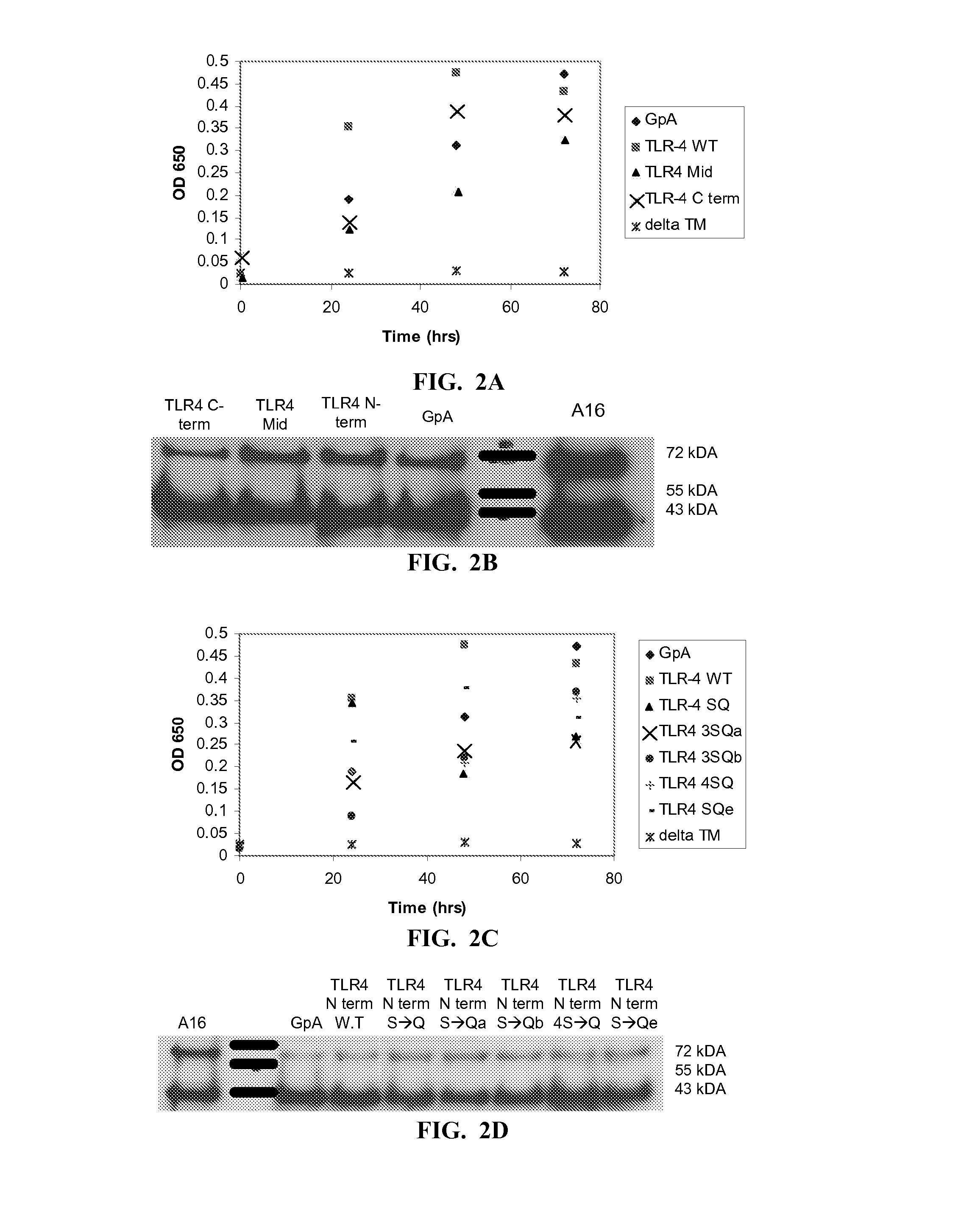Toll-Like Receptor 4 (Tlr-4) Agonist Peptides For Modulating Tlr-4 Mediated Immune Response
a technology of tlr-4 and agonist peptides, which is applied in the direction of peptides, antibody medical ingredients, peptides/protein ingredients, etc., can solve the problem that the knowledge of the factors that control the receptor oligomerization process in the membrane milieu is still limited, and achieve the effect of improving tnf- secretion
- Summary
- Abstract
- Description
- Claims
- Application Information
AI Technical Summary
Benefits of technology
Problems solved by technology
Method used
Image
Examples
example 1
Homodimerization of TLR-4 Hydrophobic Segments
[0139]Using several topological predication algorithms, a region of 30 amino acids of the murine TLR-4 was identified as the putative transmembranal domain (630TIISVSVVSVIVVSTVAFLIYHFYFHLILI659; SEQ ID NO: 22). The predicted TM was divided into three segments: TLR-4 TM N-term (SEQ ID NO: 23), TLR-4 TM mid (SEQ ID NO: 24) and TLR-4 TM C-term (SEQ ID NO: 25). In order to determine the involvement of the TM domain in the dimerization of the receptor, a ToxR assembly system comprising the different segment was constructed (Table 2, bold and underlined letters are mutations in the wild type sequences). The ToxR system can detect self-association within the inner membrane of E. coli (Langosch et al., 1996). The different segments (TLR-4 TM N, mid and C) showed 35, 50 and 95% dimerization activity relative to Glycophorin A (GpA) having the amino acid sequence as set forth in SEQ ID NO: 47 used as a positive control for strong dimerization withi...
example 2
Insertion and Expression Control of the TLR-4 TM Constructs
[0142]To exclude the possibility that the difference between the dimerization activities of the constructs resulted from different expression levels of the chimera proteins, or alternatively, from a failure of the constructs to properly insert into the membrane, Western blotting and maltose complementation assays were performed (FIGS. 2A-H).
[0143]Correct integration of the ToxR-TM-MalE chimera proteins into the inner membrane of E. coli assessed by examining the ability of the mutants to functionally complement a MalE-deficient E. coli strain (PD28). Since PD28 cells are unable to grow on minimal medium containing maltose as the only carbon source, only cells that express the chimera protein in the correct orientation (MalE pointing toward the periplasm) are able to utilize maltose and thus allow cell growth. PD28 cells were transformed and grown in minimal medium containing maltose. All constructs showed growth curves simil...
example 3
RAW264.7 Macrophages Stimulation by the Peptides of the Invention Induce TNF-α Secretion
[0145]Based on the homodimerization results, several TLR-4 homologous peptides, corresponding to the different TM segments and mutations were synthesized (Table 3; bold and underlined letters are mutations in the wild type sequences). The peptides ability to alter TNF-α secretion by macrophages, as a marker for TLR-4 activation, was examined. Medium samples were collected after 6, 10 and 24 hours. The % of TNF-α secreted by the cells was normalized to the cytokine concentration in the medium of cells that were stimulated with LPS (10 ng / mL). Untreated cells served as controls.
TABLE 3Synthetic peptides derived from TLR-4TM domainSEQIDPeptideSequenceNO:TLR4 TM N-Term wtKKTIISVSVVSVIVVSTVKK37TLR4 TM N-Term SQKKTIISVQVVQVIVVSTVKK38TLR4 TM N-Term SAKKTIISVAVVAVIVVSTVKK39TLR4 TM N-Term shortKKTIISVSVVSVIV40TLR4 TM mid shortKKSVIVVSTVAFLI41TLR4 TM C-Term shortKKAFLIYHFYFHLI42TLR4 TM N-Term short KKTLLSV...
PUM
| Property | Measurement | Unit |
|---|---|---|
| mole fraction | aaaaa | aaaaa |
| mole fraction | aaaaa | aaaaa |
| mole fraction | aaaaa | aaaaa |
Abstract
Description
Claims
Application Information
 Login to View More
Login to View More - R&D
- Intellectual Property
- Life Sciences
- Materials
- Tech Scout
- Unparalleled Data Quality
- Higher Quality Content
- 60% Fewer Hallucinations
Browse by: Latest US Patents, China's latest patents, Technical Efficacy Thesaurus, Application Domain, Technology Topic, Popular Technical Reports.
© 2025 PatSnap. All rights reserved.Legal|Privacy policy|Modern Slavery Act Transparency Statement|Sitemap|About US| Contact US: help@patsnap.com



